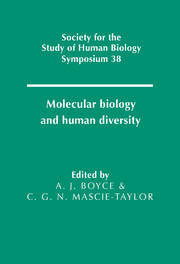Book contents
- Frontmatter
- Contents
- List of contributors
- Preface
- 1 Mitochondrial DNA in ancient and modern humans
- 2 Digital DNA typing of human paternal lineages
- 3 Minisatellites as tools for population genetic analysis
- 4 DNA fingerprinting: development of a technology and its application to the study of human populations
- 5 Kinship, inbreeding, and matching probabilities
- 6 Using the coalescent to interpret gene trees
- 7 Some attempts at measuring natural selection by malaria
- 8 AIDA: Geographical patterns of DNA diversity investigated by autocorrelation statistics
- 9 Mitochondrial DNA sequences in Europe: an insight into population history
- 10 Palaeolithic and neolithic contributions to the European mitochondrial gene pool
- 11 The molecular diversity of the Niokholo Mandenkalu from Eastern Senegal: an insight into West Africa genetic history
- 12 The peopling of Madagascar
- 13 Molecular perspectives on the colonisation of the Pacific
- 14 Population ancestry on Tristan da Cunha–the evidence of the individual
- 15 Linguistic divergence and genetic evolution: a molecular perspective from the New World
- 16 Allelic sequence diversity at the human β-globin locus
- 17 A nuclear perspective on human evolution
- 18 Contrasting gene trees and population trees of the evolution of modern humans
- 19 Methods and models for understanding human diversity
- Index
8 - AIDA: Geographical patterns of DNA diversity investigated by autocorrelation statistics
Published online by Cambridge University Press: 19 September 2009
- Frontmatter
- Contents
- List of contributors
- Preface
- 1 Mitochondrial DNA in ancient and modern humans
- 2 Digital DNA typing of human paternal lineages
- 3 Minisatellites as tools for population genetic analysis
- 4 DNA fingerprinting: development of a technology and its application to the study of human populations
- 5 Kinship, inbreeding, and matching probabilities
- 6 Using the coalescent to interpret gene trees
- 7 Some attempts at measuring natural selection by malaria
- 8 AIDA: Geographical patterns of DNA diversity investigated by autocorrelation statistics
- 9 Mitochondrial DNA sequences in Europe: an insight into population history
- 10 Palaeolithic and neolithic contributions to the European mitochondrial gene pool
- 11 The molecular diversity of the Niokholo Mandenkalu from Eastern Senegal: an insight into West Africa genetic history
- 12 The peopling of Madagascar
- 13 Molecular perspectives on the colonisation of the Pacific
- 14 Population ancestry on Tristan da Cunha–the evidence of the individual
- 15 Linguistic divergence and genetic evolution: a molecular perspective from the New World
- 16 Allelic sequence diversity at the human β-globin locus
- 17 A nuclear perspective on human evolution
- 18 Contrasting gene trees and population trees of the evolution of modern humans
- 19 Methods and models for understanding human diversity
- Index
Summary
Introduction
Geographical patterns of genetic diversity contain information on the evolutionary processes affecting individuals and populations. For example, random patterns, clines, and patchy distributions may result from different evolutionary phenomena (like panmixia, response to a selective gradient, and isolation by distance, respectively), which one may be willing to reconstruct. In some cases, a simple visual inspection of data is sufficient. Figure 8.1 shows two maps of human allele frequencies in Europe based on several tens of population data (Sokal, Harding & Oden, 1989). These maps were obtained by interpolation, and different shades of grey indicate different classes of allele frequencies. The upper distribution refers to an allele of the HLA-B locus, HLA*BW15. There is no need of sophisticated statistical tests to see that its frequencies are distributed in a gradient, with maxima in Scandinavia and Finland, and an area of low values around the Mediterranean. Other cases are, however, ambiguous. One cannot easily tell if the lower part of Fig. 8.1 (allele 1 of the Group-specific component) is a cline extending from the Southwest to the Northeast on which random variation has been superimposed, if it should be regarded as the overlapping of two clinal patterns, or even if it may simply reflect drift and local gene flow, i.e., isolation by distance.
- Type
- Chapter
- Information
- Molecular Biology and Human Diversity , pp. 93 - 111Publisher: Cambridge University PressPrint publication year: 1996



